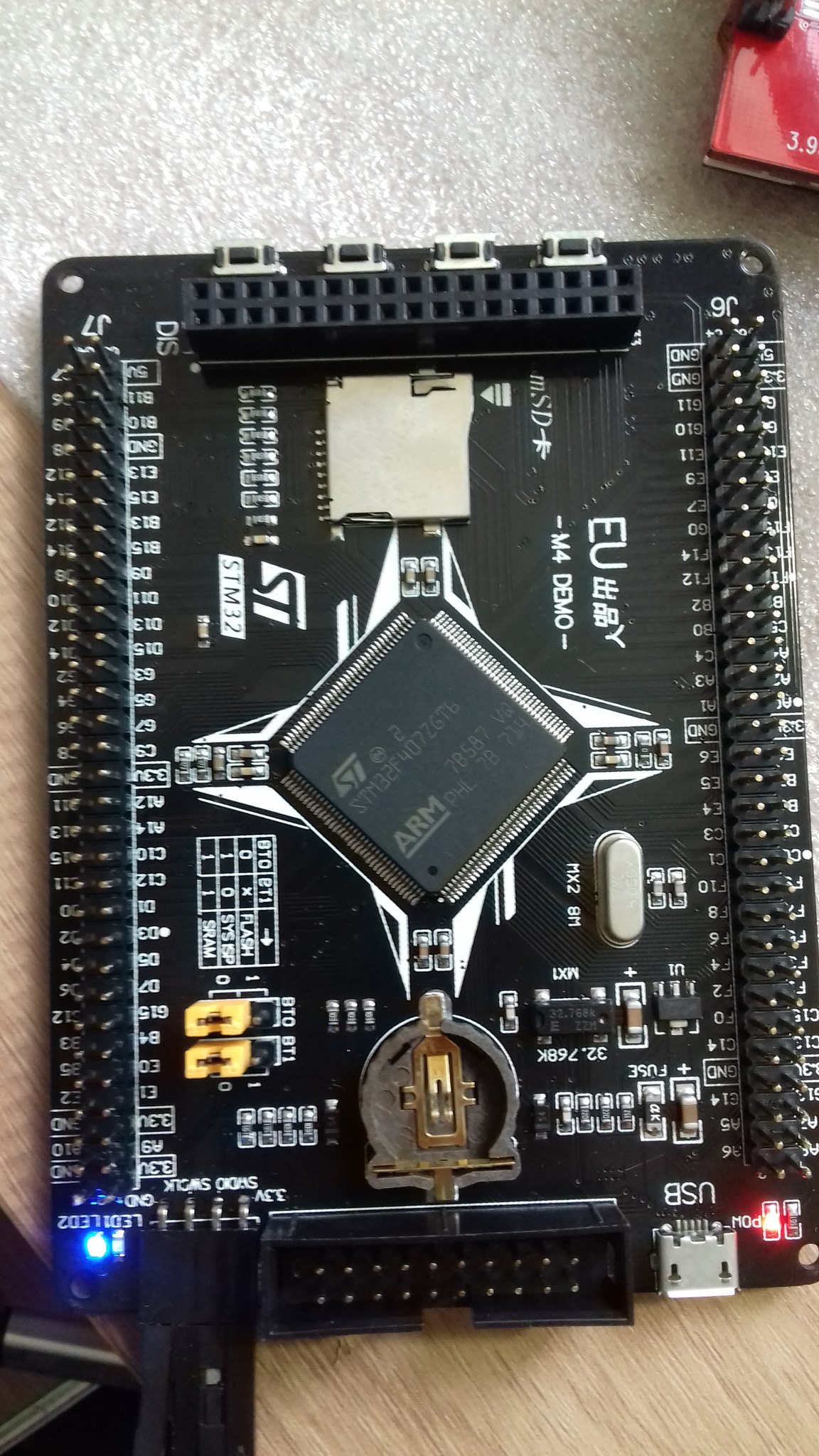[STM32]: Blinking leds on stm32f407zgt6
After working on STM32F103C8T6 aka “Blue-Pill” for a while, I have decided to have more adeventures by trying STM32f407ZGT6 board. This board costs around 14$ from Aliexpress and I got delived this board in 7 days from China.

Key Features
- Core: ARM® 32-bit Cortex® -M4 CPU with FPU, Adaptive real-time accelerator (ART Accelerator™) allowing 0-wait state execution from Flash memory, frequency up to 168 MHz, memory protection unit, 210 DMIPS/1.25 DMIPS/MHz (Dhrystone 2.1), and DSP instructions
- Memories
Up to 1 Mbyte of Flash memory
Up to 192+4 Kbytes of SRAM including 64-Kbyte of CCM (core coupled memory) data RAM Flexible static memory controller supporting Compact Flash, SRAM, PSRAM, NOR and NAND memories - LCD parallel interface, 8080/6800 modes
- Clock, reset and supply management 1.8 V to 3.6 V application supply and I/Os POR, PDR, PVD and BOR 4-to-26 MHz crystal oscillator Internal 16 MHz factory-trimmed RC (1% accuracy) 32 kHz oscillator for RTC with calibration Internal 32 kHz RC with calibration Sleep, Stop and Standby modes VBAT supply for RTC, 20×32 bit backup registers + optional 4 KB backup SRAM
- 3×12-bit, 2.4 MSPS A/D converters: up to 24 channels and 7.2 MSPS in triple interleaved mode
- 2×12-bit D/A converters
- General-purpose DMA: 16-stream DMA controller with FIFOs and burst support Up to 17 timers: up to twelve 16-bit and two 32-bit timers up to 168 MHz, each with up to 4 IC/OC/PWM or pulse counter and quadrature (incremental) encoder input
- Debug mode Serial wire debug (SWD) & JTAG interfaces Cortex-M4 Embedded Trace Macrocell™
- Up to 140 I/O ports with interrupt capability Up to 136 fast I/Os up to 84 MHz Up to 138 5 V-tolerant I/Os
- Up to 15 communication interfaces Up to 3 × I2 C interfaces (SMBus/PMBus) Up to 4 USARTs/2 UARTs (10.5 Mbit/s, ISO 7816 interface, LIN, IrDA, modem control) Up to 3 SPIs (42 Mbits/s), 2 with muxed full-duplex I2S to achieve audio class accuracy via internal audio PLL or external clock 2 × CAN interfaces (2.0B Active) SDIO interface
- Advanced connectivity USB 2.0 full-speed device/host/OTG controller with on-chip PHY USB 2.0 high-speed/full-speed device/host/OTG controller with dedicated DMA, on-chip full-speed PHY and ULPI 10/100 Ethernet MAC with dedicated DMA: supports IEEE 1588v2 hardware, MII/RMII
- 8- to 14-bit parallel camera interface up to 54 Mbytes/s
- True random number generator
- CRC calculation unit
- 96-bit unique ID
- RTC: subsecond accuracy, hardware calendar
For more information, go to STMicroelectronics product page
Install gcc and newlib
$ sudo pacman -S arm-none-eabi-gcc arm-none-eabi-newlibInstall stlink and openocd
stlink is a tool to download the compiled binary to the microcontroller and OpenOCD is an on-chip debugger. I shall cover OpenOCD in future tutorials.
$ sudo pacman -S stlink openocdinstall libopencm3
Libopencm3 is a nice opensource C library for cortex M0/M1/M3/M4 and other MCUs.
$ git clone https://github.com/libopencm3/libopencm3
$ cd libopencm3
$ makeThis should compile without any issue.
Write your blink LED sketch
This boards has two LEDs at PC0 and PD3.
gpio_toggle() is the function to toggle the state of GPIOs and we would be using this function to blink the onboard leds.
#include <libopencm3/stm32/rcc.h>
#include <libopencm3/stm32/gpio.h>
#include <libopencm3/cm3/nvic.h>
#include <libopencm3/cm3/systick.h>
static volatile uint32_t system_ms = 0;
static void gpio_setup(void)
{
// LED2 - PD3
rcc_periph_clock_enable(RCC_GPIOD);
gpio_mode_setup(GPIOD, GPIO_MODE_OUTPUT,
GPIO_PUPD_NONE, GPIO3);
//LED1 - PC0
rcc_periph_clock_enable(RCC_GPIOC);
gpio_mode_setup(GPIOC, GPIO_MODE_OUTPUT,
GPIO_PUPD_NONE, GPIO0);
}
static void systick_setup(void)
{
// 16MHz/8 = 2000000
systick_set_clocksource(STK_CSR_CLKSOURCE_AHB_DIV8);
// 2000000/2000 = 1000
/* SysTick interrupt every N clock pulses: set reload to N-1 */
systick_set_reload(1999);
systick_interrupt_enable();
/* Start counting. */
systick_counter_enable();
}
void sys_tick_handler(void)
{
system_ms++;
}
static void delay(uint32_t delay_ms)
{
uint32_t future_ms = system_ms + delay_ms;
while (future_ms > system_ms);
}
int main(void)
{
//default speed is 16MHz set by libopencm3
gpio_setup();
systick_setup();
while (1)
{
gpio_set(GPIOC, GPIO0);
delay(400);
gpio_clear(GPIOC, GPIO0);
gpio_set(GPIOD, GPIO3);
delay(400);
gpio_clear(GPIOD, GPIO3);
}
return 0;
}svn command can be used to download complete blink sample code.
$ svn export https://github.com/amitesh-singh/amiduino/trunk/stm32/f4/systick
A systick
A systick/Makefile
A systick/libopencm3-examples-rules.mk
A systick/libopencm3-examples-stm32f4.mk
A systick/skeleton.c
A systick/skeleton.ld
Exported revision 367.
$ cd systick/
$ ls
libopencm3-examples-rules.mk libopencm3-examples-stm32f4.mk
Makefile skeleton.c skeleton.ldYou might need to modify the libopencm3 repo path in libopencm3-examples-rules.mk. In my case, it is set to $(HOME)/repos/libopencm3.
libopencm3-examples-rules.mk
...
###############################################################################
# Source files
OBJS += $(BINARY).o
ifeq ($(strip $(OPENCM3_DIR)),)
# user has not specified the library path, so we try to detect it
# where we search for the library
#LIBPATHS := ./libopencm3 ../../../../libopencm3 ../../../../../libopencm3
LIBPATHS := $(HOME)/repos/libopencm3
..
..Build the blink program.
$ make
CC skeleton.c
LD skeleton.elf
OBJCOPY skeleton.binUploading the program
You will need ST Link V2 programmer to upload the code.
$ st-flash write skeleton.bin 0x08000000
st-flash 1.3.0
2017-09-02T12:45:20 INFO src/usb.c: -- exit_dfu_mode
2017-09-02T12:45:21 INFO src/common.c: Loading device parameters....
2017-09-02T12:45:21 INFO src/common.c: Device connected is: F4 device, id 0x10076413
2017-09-02T12:45:21 INFO src/common.c: SRAM size: 0x30000 bytes (192 KiB), Flash: 0x100000 bytes (1024 KiB) in pages of 16384 bytes
2017-09-02T12:45:21 INFO src/common.c: Attempting to write 908 (0x38c) bytes to stm32 address: 134217728 (0x8000000)
Flash page at addr: 0x08000000 erased
2017-09-02T12:45:21 INFO src/common.c: Finished erasing 1 pages of 16384 (0x4000) bytes
2017-09-02T12:45:21 INFO src/common.c: Starting Flash write for F2/F4/L4
2017-09-02T12:45:21 INFO src/flash_loader.c: Successfully loaded flash loader in sram
enabling 32-bit flash writes
size: 908
2017-09-02T12:45:21 INFO src/common.c: Starting verification of write complete
2017-09-02T12:45:21 INFO src/common.c: Flash written and verified! jolly good!You should see two blue LEDs blinking.
New stm32f407 board. It blinks. #libopencm3 #stm32 pic.twitter.com/zt13BxRfAQ
— FAITH + 1 (@amitesh_singh) September 2, 2017